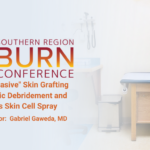Abstract | December 20, 2021
“Minimally Invasive” Skin Grafting with Enzymatic Debridement and Autologous Skin Cell Spray
Learning Objectives
- Discuss use of ASCS and bromelain in combination.
- Realize potential for donor site reduction with novel therapies.
Introduction:
Minimally invasive surgery is increasingly becoming standard of care across numerous subspecialties. However, burn surgery has lagged behind; as the mainstay of reconstruction still involves wound excision with a knife, a commensurately sized skin graft, and a painful donor site. In recent years, several new technologies have the potential to be used synergistically to perform “minimally invasive” skin grafts. Enzymatic debridement with bromelain and autologous skin cell spray (ASCS) have independently been shown to reduce the rate of split thickness skin grafting and decrease the donor site size when grafting is performed. Due to constraints regarding the temporal course of these products only being available via studies before one was FDA approved, these two technologies have not been utilized together in the United States until recently. A paucity of literature regarding their use in combination currently exists. The purpose of this study is to characterize a cohort of patients treated with both bromelain and ASCS, and qualitatively compare data to expected outcomes without these therapies.
Methods:
Study design: This was a retrospective study of a single academic burn center’s experience using bromelain and ASCS together. Data collection included demographics, injury characteristics, length of stay, infections, graft loss >25%, and surgical procedures performed. Total square centimeters treated with ASCS, autograft, and total donor site size was tabulated. A ratio of donor site size to total area treated was calculated. Length of stay (LOS) was qualitatively compared to expected using a factor of 1.1days per %TBSA, and LOS index was calculated. Data was reported in medians with interquartile ranges. Care protocol: Patients with burn size >1%TBSA and<30% TBSA with at least >50% deep partial thickness burns qualified for the bromelain study. Patients were debrided with bromelain per the continued access study protocol over a 4-hour period. Those with deep partial thickness burns with enough dermis amenable autologous skin cell spray alone were treated as such. Those with areas of third degree burns also received targeted meshed patch split thickness skin grafts with ASCS overspray. ASCS was applied to deep partial thickness burns after a prep with superficial dermabrasion under a transparent polyethylene dressing or a polylactic acid sheet in the operating room. Outer dressings were changed every other day.
Results:
Nine patients were included in the study. Three patients received ASCS alone, while 6 patients received a meshed STSG for at least part of their injury. Median burn size was 13% TBSA (IQR:5,20), while DPT+FT size was 9% TBSA (IQR:5,16). Patients had a median of 1067 sq cm (IQR:772,2183) of burn operatively treated with ASCS, and 351 sq cm (IQR:0,457) treated with meshed autograft. Donor site size (ASCS and STSG) was 225 sq cm (IQR:72,315), and ratio of donor site are to total treatment area was 0.0125 (IQR:0.01,0.32). Median LOS was 11 days (IQR:7,21), and LOS index measured in days per %TBSA was 0.77 (IQR:0.5,1.16). Expected LOS was 14.3 days, with an O/E ratio of 0.77. One elderly patient with multiple vitamin deficiencies and history of alcohol abuse treated with ASCS alone and developed an infection and required STSG of over 50% of his treated area.
Conclusions:
Enzymatic debridement and ASCS can be utilized to treat burn injury with a “minimally invasive” reconstruction. The donor sites in both of these patients were much smaller than expected had they been treated with a conventional meshed split thickness skin graft for all of their deep 2nd degree and 3rd degree areas. The data also suggests that length of stay is lower than expected based on burn size. Further study is needed to determine which subsets of patients and burn wound characteristics are optimal for this combination of technologies. More data regarding outcomes such as length of stay, costs, and scar formation compared to standard of care is also warranted.

